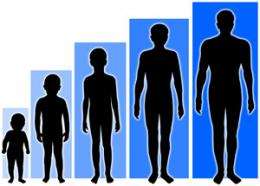A 'giant' step toward explaining differences in height: Scientists map height 'hotspots' in the genome

(PhysOrg.com) -- An international collaboration of more than 200 institutions, led by researchers at Children's Hospital Boston, the Broad Institute, and a half-dozen other institutions in Europe and North America, has identified hundreds of genetic variants that together account for about 10 percent of the inherited variation of height among people.
Known as the GIANT (Genetic Investigation of ANthropometric Traits) Consortium, the collaboration pooled data from more than 180,000 individuals, including millions of genetic results from each of 46 separate studies in the U.S., Canada, Europe and Australia. In the September 29 advance online edition of the journal Nature, the researchers report hundreds of genetic variants associated with height, located in at least 180 different spots in the genome (known as loci).
They further showed that these variants cluster consistently around genes from at least six different biological pathways. Many are located near genes already known to be involved in skeletal growth syndromes, while others implicate previously unrecognized genetic growth regulators, opening up new frontiers for biological studies of height.
"Height clearly has a lot to do with genetics - shorter parents tend to have shorter children, and taller parents tend to have taller children," says Joel Hirschhorn, MD, PhD, of Children's Hospital Boston, the Broad Institute and Harvard Medical School, and co-senior author on the paper with Timothy Frayling, PhD, of the University of Exeter (UK). "This paper is the biggest step forward to date in understanding which of the genetic variants that differ between people account for our differences in height."
To look for genes affecting height, Hirschhorn and colleagues used so-called genome-wide association (GWA) studies. These studies cast a wide net, sampling millions of sites of genetic variation in large groups of people and crunching the data to search for consistent differences in height associated with any of the variants in the genome. When study populations are large enough, these associated variants can be signposts for genes that contribute to traits like height, which vary widely from person to person for many different genetic reasons.
"A good bit of the genetic differences in height is going to be explained by common variants that individually have very small effects," says Hirschhorn. "We all carry many different variants that each make us slightly taller or shorter."
At least 19 locations in the genome had multiple variants that were independently associated with height, suggesting that the nearby genes are important in regulating childhood growth and may account for an appreciable fraction of existing height-related variation.
The study also addresses two controversies in the genetics field. One involves the value of GWA studies themselves. Critics argue that while these studies have, to date, identified more than 1,000 variants that are associated with human diseases and traits, they don't tell us much useful information about the underlying biology.
The GIANT GWA of height, which discovered more genetic variants influencing a trait than any prior genetic study, demonstrates the value of GWA studies with large populations. "With enough statistical power, you can identify lots of loci, and clearly relevant biological pathways emerge that were not evident in smaller studies," says Hirschhorn.
The second controversy involves the role of rare versus common genetic variants. Many scientists believe that genetic variants that alter gene function and influence diseases or traits are rare (occurring in 1 percent or less of the population), since natural selection would tend to weed them out of the population.
"What we show is that for at least some cases, it's the common variant that has the effect," says Hirschhorn. "More importantly, they cluster in consistent areas near or within particular genes that highlight biological pathways - they're not randomly strewn across the genome."
Despite the large number of loci identified by the study, the fraction of variation in height explained by these loci remains modest, about 10 percent. "Genome-wide association studies are very powerful tools, but even so, we are still some way short of understanding the full details of how differences in our genomes influence common human traits such as height," says Frayling. "Complex traits such as height are proving even more complex than we had first thought. We will need even more powerful tools and different approaches if we are to understand fully the differences between individuals."
Height is a classic model for genetic research on complex traits, because it's easily measured and varies greatly from individual to individual. Unlike Mendelian genetics where a single inherited gene determines whether a pea is green or yellow, height has many gradations and is the sum product of multiple genes. "If we can understand the genetics of height, it will help us understand how other polygenic traits are inherited," says Hirschhorn.
More information: The paper, "Hundreds of Variants Clustered in Genomic Loci and Biological Pathways Affect Human Height", appears in the September 29 online edition of Nature.















